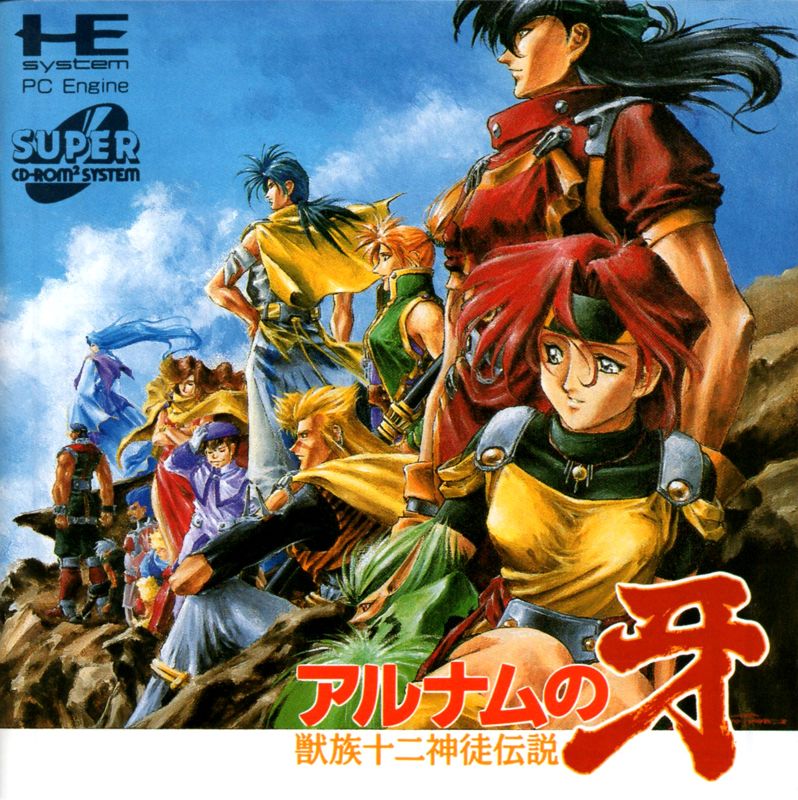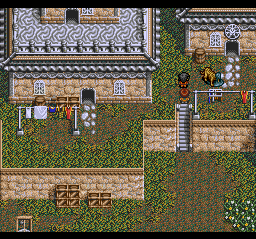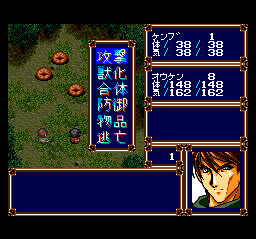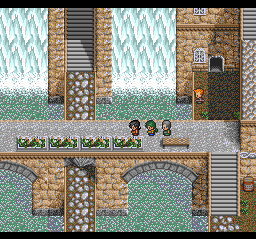Retro Replay Review
Gameplay
Alnam no Kiba delivers a classic Japanese RPG experience with its top-down exploration and turn-based combat system. Players guide Kenbu and his allies across a sprawling world map, entering towns, forests, and ancient ruins as they unravel the mystery behind the spider-like assault on Kenbu’s village. The navigation feels smooth and intuitive, with clear menus for equipment, magic, and party formation.
(HEY YOU!! We hope you enjoy! We try not to run ads. So basically, this is a very expensive hobby running this site. Please consider joining us for updates, forums, and more. Network w/ us to make some cash or friends while retro gaming, and you can win some free retro games for posting. Okay, carry on 👍)
The heart of the gameplay lies in its spirit points mechanic. Every action—whether a basic sword slash, a healing spell, or a devastating unite attack—consumes SP. This resource management adds tension to each encounter, forcing players to balance aggression and conservation. Finding SP-restoring items in dungeons and resting at inns becomes a tactical choice rather than a mere afterthought.
Random encounters are frequent, but they rarely feel unfair. The enemy variety—from lowly forest beasts to imposing dungeon guardians—keeps combat fresh. Battles are viewed from the same perspective as exploration, giving a consistent feel to the entire adventure. Unite attacks, which strike all foes at once, serve as gratifying payoff for strategic SP buildup, ensuring that each hard-won victory feels earned.
Side quests pepper the journey, offering everything from simple fetch missions to mini-challenges that unlock new transformations. As Kenbu masters different beast forms, new abilities open up both in and out of battle—allowing for creative puzzle-solving and varied combat tactics. This blend of exploration, resource strategy, and character progression ensures that gameplay remains engaging throughout.
Graphics
Alnam no Kiba embraces a retro aesthetic reminiscent of early 16-bit-era RPGs, yet it refines the formula with detailed pixel art and rich color palettes. Each environment—from the tranquil village outskirts to the shadowy depths of spider-infested caverns—feels distinct and atmospheric. Sprite animations for walking, attacking, and shapeshifting are fluid, lending personality to every character and enemy.
Character portraits during dialogue convey emotion effectively, with expressive eyes and subtle shading that highlight moments of joy, grief, or determination. The UI is cleanly designed: battle menus are easy to navigate, and health and SP bars are prominent without cluttering the screen. Map icons and dungeon layouts use a consistent visual language that helps players orient themselves without constant menu checks.
Boss encounters receive extra visual flair. The hideous spider-like monster that opens the game towers over Kenbu in silhouette, its many legs and glowing eyes rendered with chilling detail. Later world-threatening adversaries introduce dynamic background effects—flashing runes, swirling shadows, or elemental storms—that elevate these climactic battles.
While modern gamers may find the resolution modest by today’s standards, the overall presentation exudes nostalgic charm. Every tile, from the rustling grass under Kenbu’s feet to the flickering torches in ancient halls, contributes to a cohesive and engaging visual world.
Story
At its core, Alnam no Kiba tells a deeply personal tale of loss, growth, and destiny. Kenbu begins as a hopeful youth training under his mentor’s watchful eye, only to witness that mentor’s heroic sacrifice against a nightmarish spider creature. This opening tragedy sets a poignant emotional tone, propelling Kenbu’s quest for answers and retribution.
As the story unfolds, Kenbu’s journey introduces a diverse cast of allies—each with their own motivations and backstories. The interplay between these characters adds depth to the narrative: a stoic knight haunted by past failures, a mischievous rogue seeking redemption, and a wise mage whose knowledge hints at ancient prophecies. Their interactions ground the world in relatable human struggles, from regret and guilt to hope and camaraderie.
The plot steadily escalates from village defense to world salvation, weaving in themes of nature versus corruption, the responsibilities of power, and the bonds forged in adversity. Hidden clues in dungeons, overheard NPC conversations in towns, and optional lore texts encourage players to piece together the broader mythos of the “Fang of Alnam.” This layered approach rewards curious players who delve off the beaten path.
Although the central storyline follows a familiar hero’s-journey arc, its execution shines through character development and emotional stakes. Kenbu’s evolving mastery of shape-shifting reflects his inner transformation—from a sheltered trainee to a world-saving champion—making each narrative milestone feel earned.
Overall Experience
Alnam no Kiba: Jūzoku Jūnishinto Densetsu successfully balances nostalgia and refinement, offering a satisfying retro RPG for modern audiences. Its blend of strategic SP-based battles, shapeshifting mechanics, and a heartfelt story creates an adventure that’s both approachable and deep. Fans of classic JRPGs will feel right at home, while newcomers can appreciate the game’s clear systems and engaging pacing.
The journey from Kenbu’s quiet village to the ultimate confrontation with world-threatening evil spans dozens of hours, yet the game rarely feels padded. Side quests and optional dungeons offer worthwhile detours, but the main narrative remains focused and compelling. Frequent save points, well-placed inns, and a gradual difficulty curve ensure that frustration is kept to a minimum.
Multiplayer or battle rehearsal modes are absent, but the single-player campaign stands strong on its own merits. Whether commanding a unite attack to clear a room of enemies or uncovering a hidden shrine clue that expands the story, players will find plenty of memorable moments. The combination of strategic combat, charming visuals, and an emotionally resonant plot makes Alnam no Kiba a must-play for RPG enthusiasts.
In sum, “Fang of Alnam” stakes its claim as a standout in the realm of traditional Japanese RPGs. Its affectionate homage to genre classics, paired with meaningful innovations like the SP-driven combat and shape-shifting, yields an experience that is both familiar and fresh. For those seeking a journey of heroism, loss, and world-saving triumph, Alnam no Kiba delivers on every front.
 Retro Replay Retro Replay gaming reviews, news, emulation, geek stuff and more!
Retro Replay Retro Replay gaming reviews, news, emulation, geek stuff and more!









Reviews
There are no reviews yet.